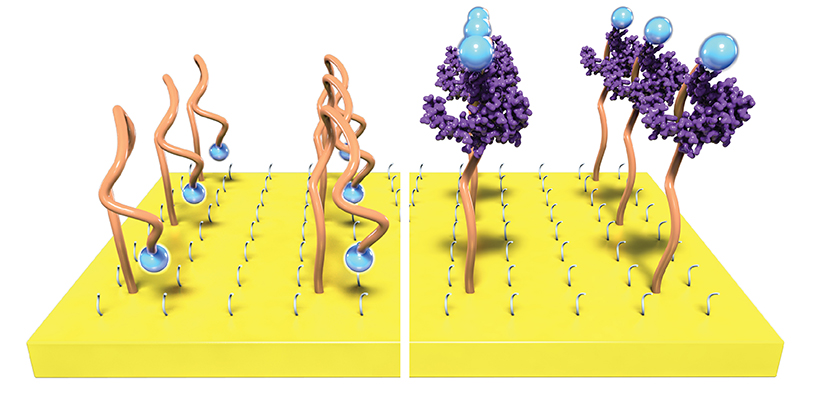Plastic Transistor Amplifies Biochemical Sensing Signal
New technology paves way for sensitive bioelectronic diagnostics
The molecules in our bodies are in constant communication. Some of these molecules provide a biochemical fingerprint that could indicate how a wound is healing, whether or not a cancer treatment is working or that a virus has invaded the body. If we could sense these signals in real time with high sensitivity, then we might be able to recognize health problems faster and even monitor disease as it progresses.
Now Northwestern Engineering researchers have developed a new technology that makes it easier to eavesdrop on our body’s inner conversations.

While the body’s chemical signals are incredibly faint — making them difficult to detect and analyze — the researchers have developed a new method that boosts signals by more than 1,000 times. Transistors, the building block of electronics, can boost weak signals to provide an amplified output. The new approach makes signals easier to detect without complex and bulky electronics.
By enabling amplification of weak biochemical signals, the new approach brings modern medicine one step closer to real-time, on-site diagnostics and disease monitoring.
The research was published March 24 in the journal Nature Communications.
“If we could reliably measure biochemical signals in the body, we could incorporate those sensors into wearable technologies or implants that have a small footprint, less burden, and don’t require expensive electronics,” said the McCormick School of Engineering’s Jonathan Rivnay, the study’s senior author. “But extracting high-quality signals has remained a challenge. With limited power and space inside the body, you need to find ways to amplify those signals.”
If we could reliably measure biochemical signals in the body, we could incorporate those sensors into wearable technologies or implants that have a small footprint, less burden, and don’t require expensive electronics. But extracting high-quality signals has remained a challenge. With limited power and space inside the body, you need to find ways to amplify those signals.
Jonathan RivnayProfessor of Biomedical Engineering
Rivnay is a professor of biomedical engineering at Northwestern Engineering. Xudong Ji, a post-doctoral researcher in Rivnay’s laboratory, is the paper’s first author.
While they communicate vital information packed with potential to guide diagnoses and treatment, many chemical sensors produce weak signals. In fact, health care professionals often cannot decipher these signals without removing a sample (blood, sweat, saliva) and running it through high-tech laboratory equipment. Usually, this equipment is expensive and perhaps even located off-site. And results can take an excruciatingly long time to return.
Rivnay’s team, however, aims to sense and amplify these hidden signals without ever leaving the body.
Other researchers have explored electrochemical sensors for biosensing using aptamers, which are single strands of DNA engineered to bind to specific targets. After successfully binding to a target of interest, aptamers act like an electronic switch, folding into a new structure that triggers an electrochemical signal. But with aptamers alone, the signals are often weak and highly susceptible to noise and distortion if not tested under ideal and well-controlled conditions.
To bypass this issue, Rivnay’s team equipped an amplifying component onto a traditional electrode-based sensor and developed an electrochemical transistor-based sensor with new architecture that can sense and amplify the weak biochemical signal. In this new device, the electrode is used to sense a signal, but the nearby transistor is dedicated to amplifying the signal. The researchers also incorporated a built-in, thin-film reference electrode to make the amplified signals more stable and reliable.

“We combine the power of the transistor for local amplification with the referencing you get from well-established electrochemical methods,” Ji said. “It’s the best of both worlds because we’re able to stably measure the aptamer binding and amplify it on site.”
To validate the new technology, Rivnay’s team turned to a common cytokine, a type of signaling protein, that regulates immune response and is implicated in tissue repair and regeneration. By measuring the concentration of certain cytokines near a wound, researchers can assess how quickly a wound is healing, if there is a new infection or whether or not other medical interventions are required.
The big vision is to implement our concept into implantable biosensors or wearable devices that can both sense a problem and then respond to it. Professor of Biomedical Engineering
In a series of experiments, Rivnay and his team were able to amplify the cytokines’ signal by three-to-four orders of magnitude compared with traditional electrode-based aptamer sensing methods. Although the technology performed well in experiments to sense cytokine signaling, Rivnay says it should be able to amplify signals from any molecule or chemical, including antibodies, hormones, or drugs, where the detection scheme uses electrochemical reporters.
“This approach is broadly applicable and doesn’t have a specific use case,” Rivnay said. “The big vision is to implement our concept into implantable biosensors or wearable devices that can both sense a problem and then respond to it.”
The study, “Organic Electrochemical Transistors as On-Site Signal Amplifier for Electrochemical Aptamer-Based Sensing,” was supported by the Defense Advanced Research Projects Agency (grant number D20AC00002).